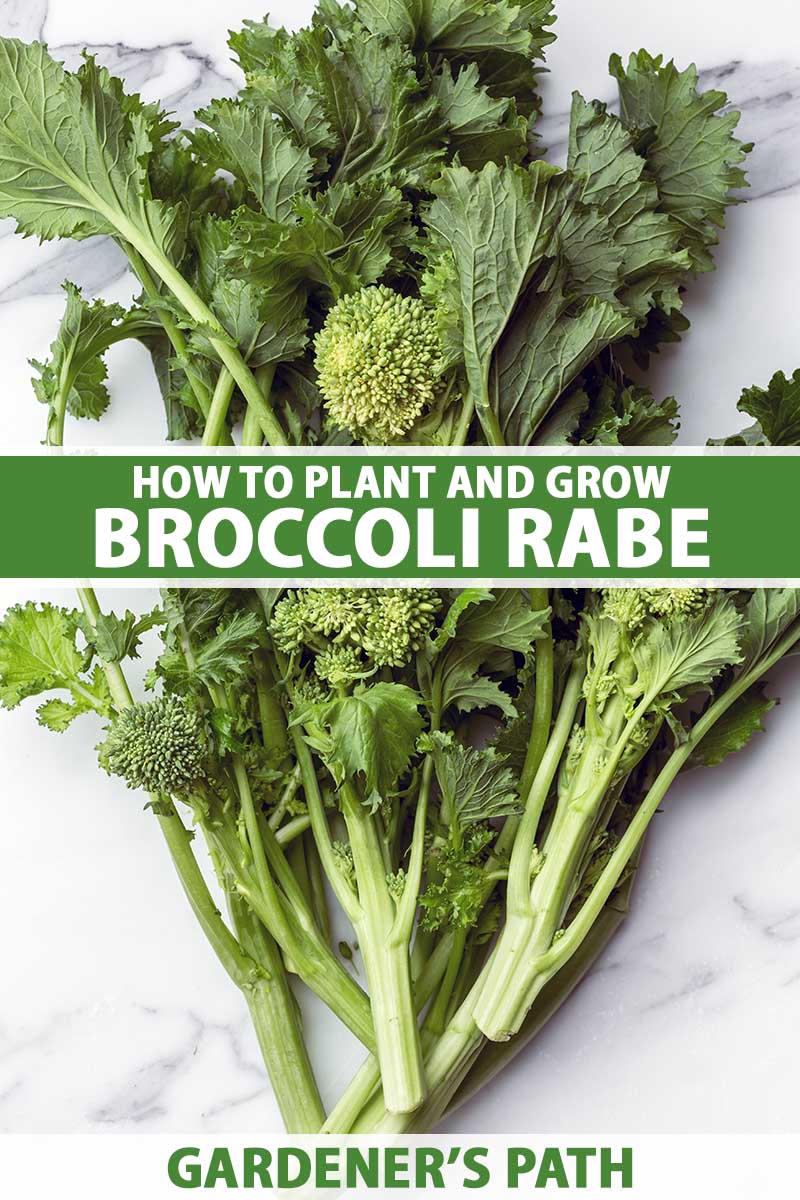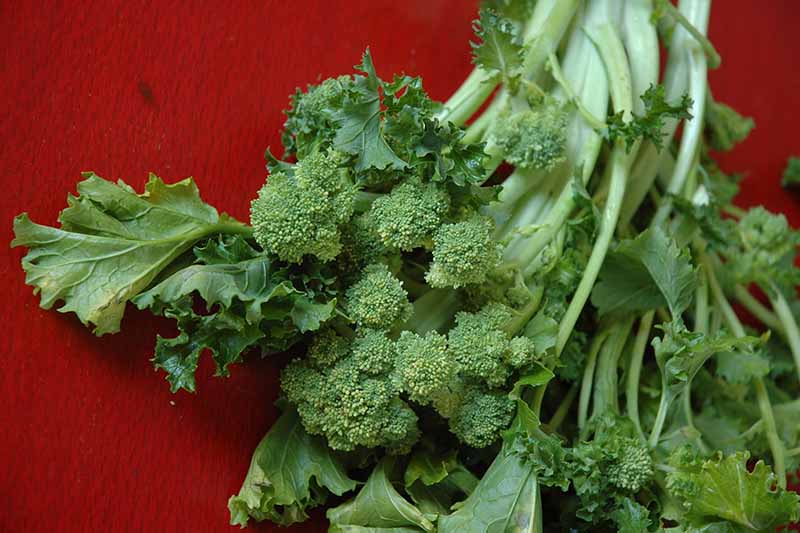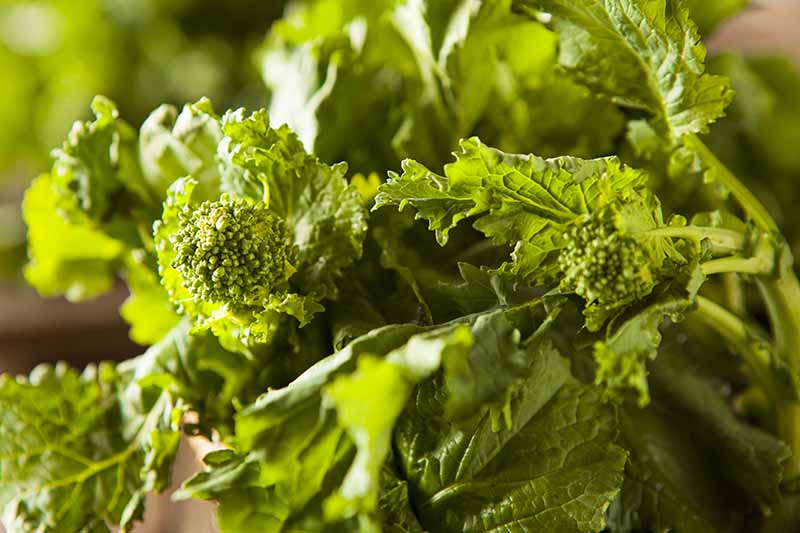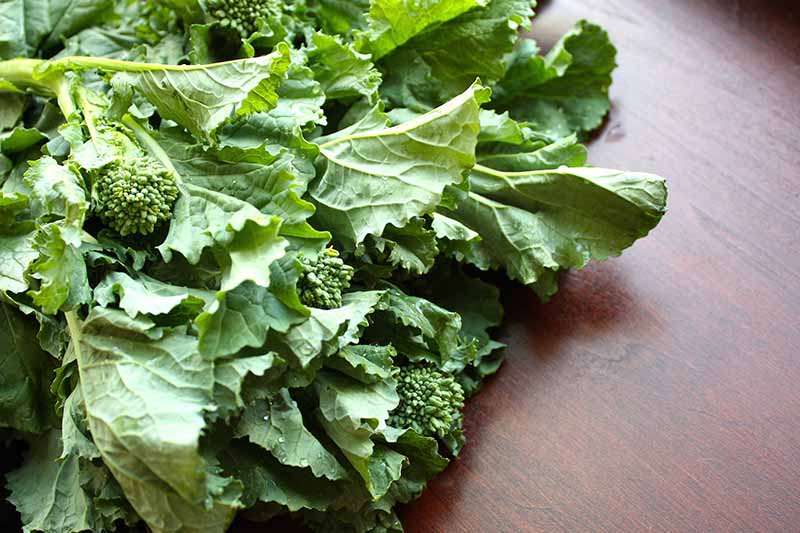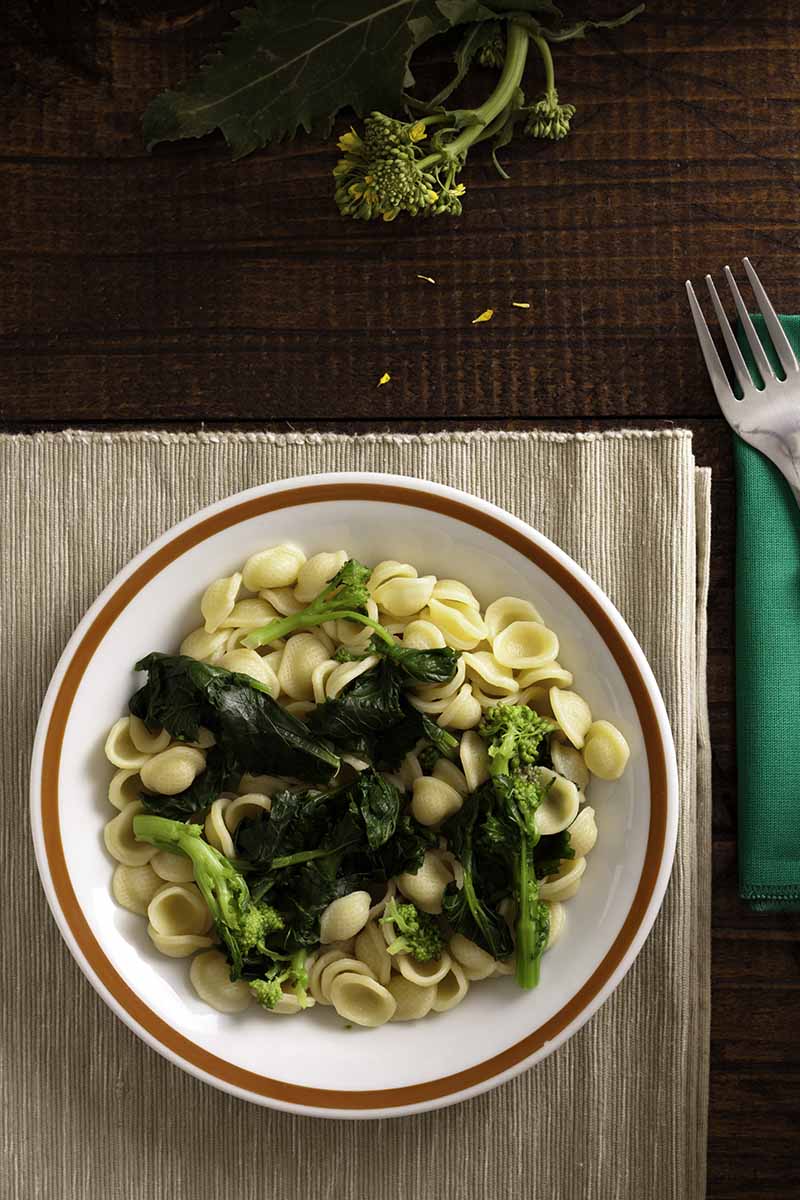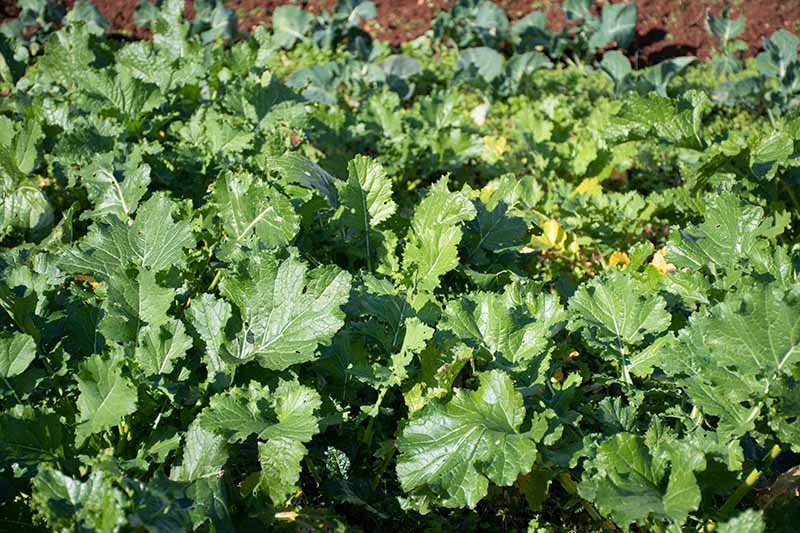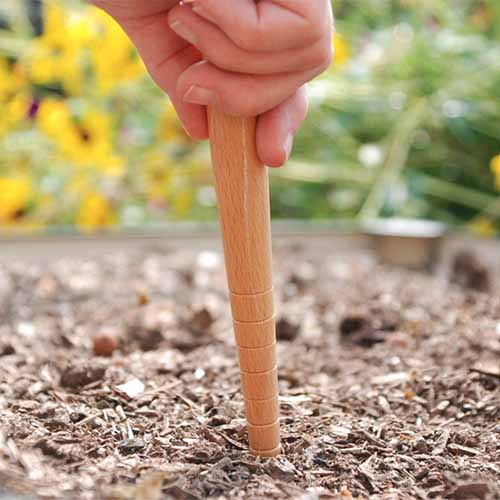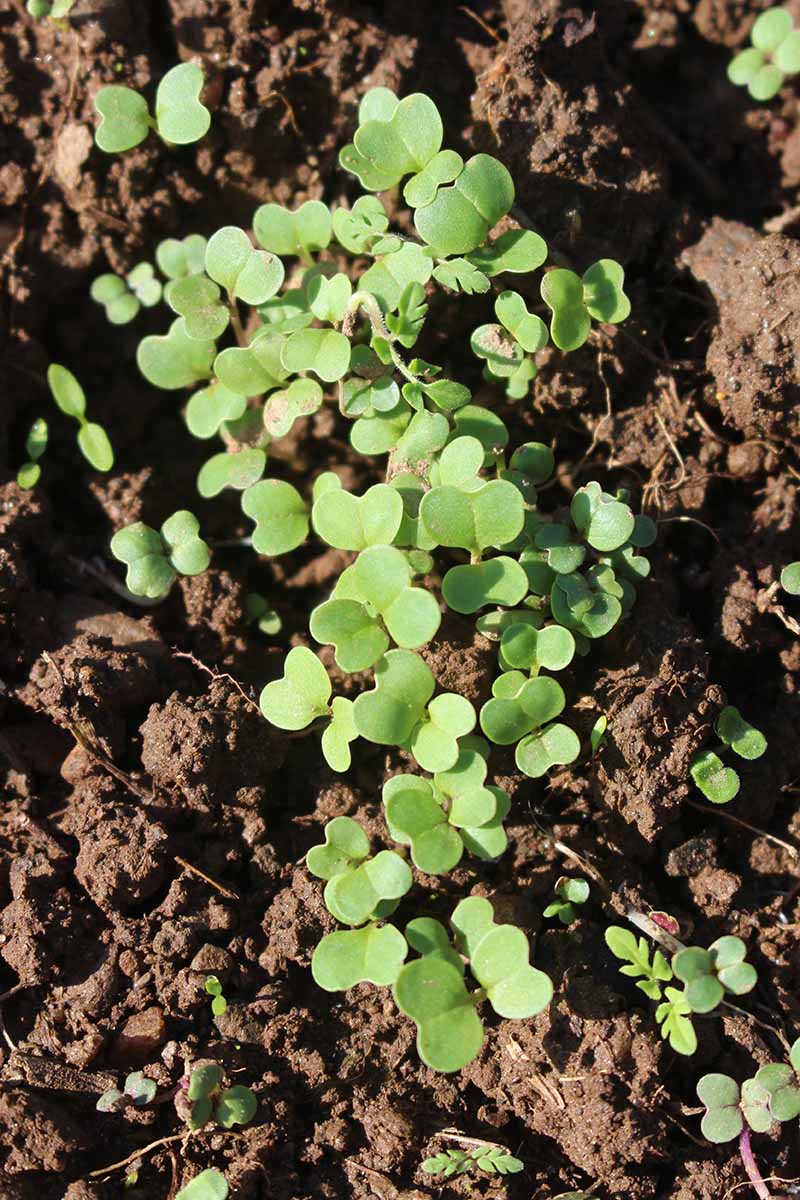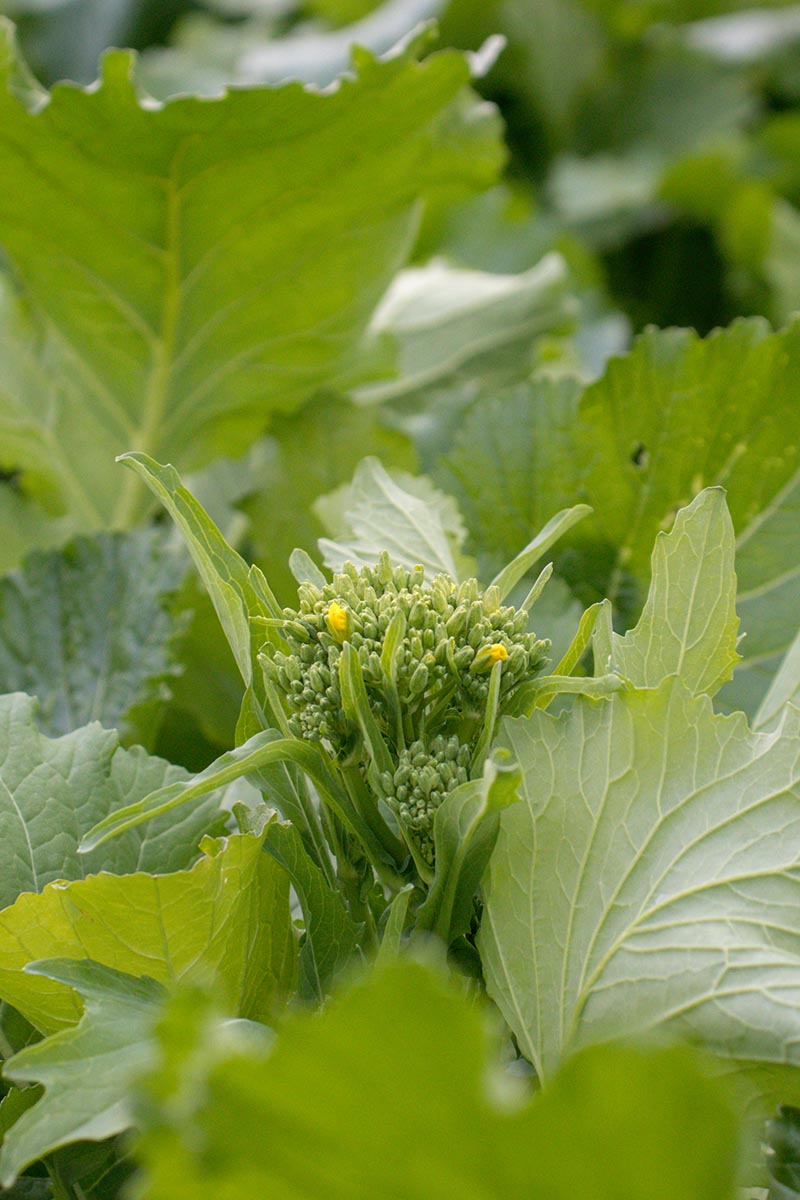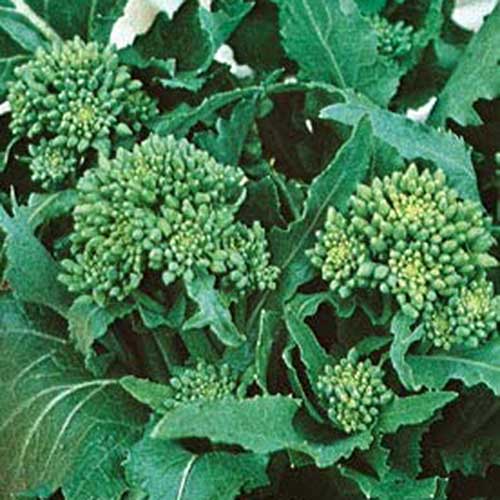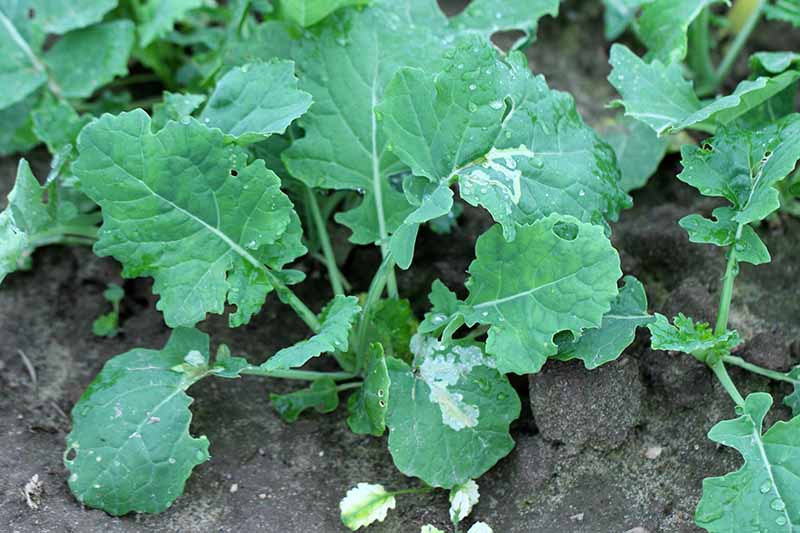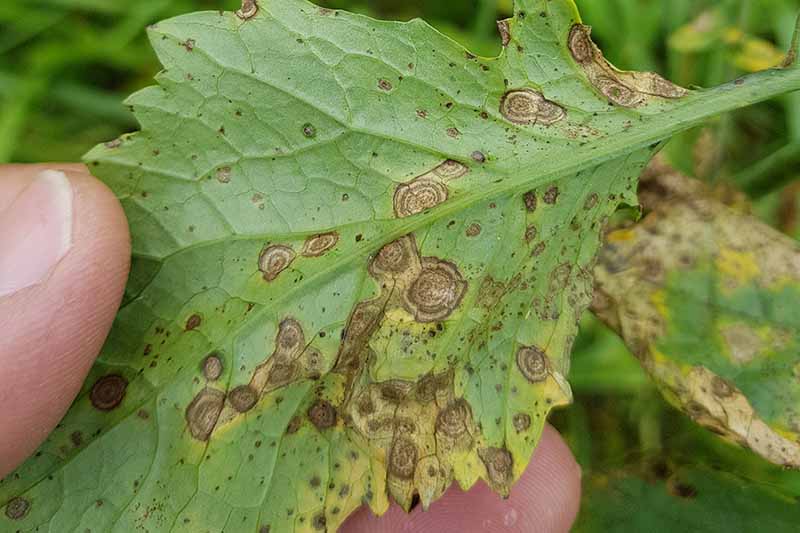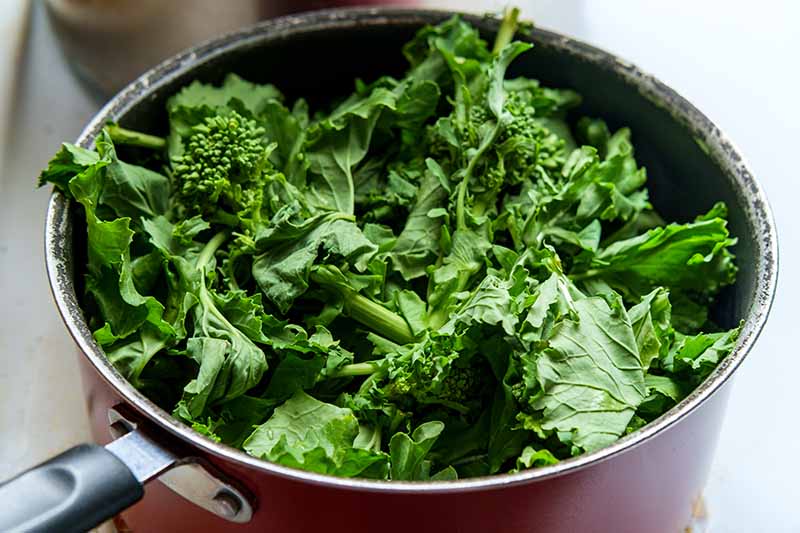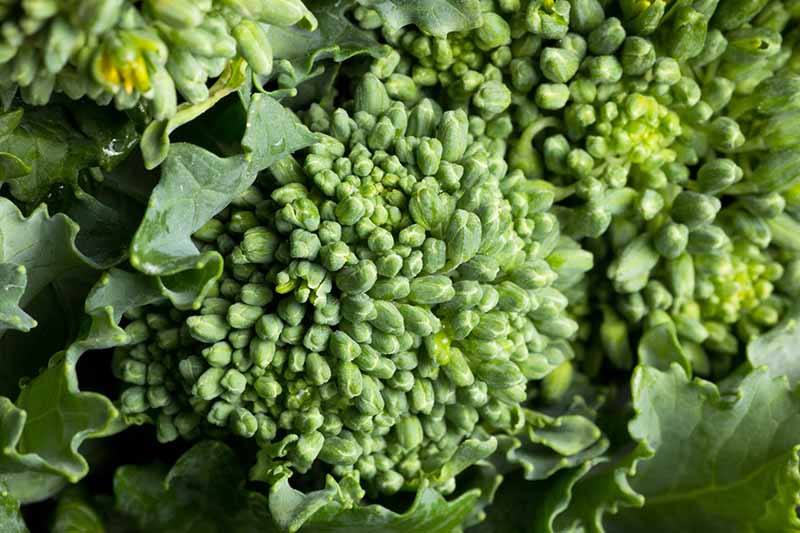While it may be somewhat uncommon fare in North America, it is a popular ingredient in both Asian and Mediterranean cuisine. Versatile in the kitchen, this cool-season vegetable is easy to grow in the garden. We link to vendors to help you find relevant products. If you buy from one of our links, we may earn a commission.
What Is Broccoli Rabe?
Broccoli rabe is one of the lesser-known cruciferous vegetables. But contrary to what its name suggests, this vegetable is not a type of broccoli – in fact, it’s more closely related to turnips. It was given the common name “broccoli rabe” because it forms little clusters of buds that look similar to heads of broccoli, only smaller. Most varieties tend to have a central “head,” but plants can produce side shoots as well. Along with edible bud clusters, the plant has leafy greens and tender stems, all of which are delectable – that is, if you enjoy a slightly bitter flavor profile. In addition to some slight bitterness, this veggie has a pungent flavor, much like a mix between turnip and mustard greens, but with a nuttier taste.
Cultivation and History
This veggie is a cultivated variety of the species Brassica rapa, a plant that is native to Northern Africa, the Mediterranean region, and the Middle East. Other cultivated forms of the B. rapa species that you are no doubt familiar with include turnips, bok choy, napa cabbage, and some types of mustard greens. The scientific name of this plant varies depending on who you’re talking to. In addition to its classification as B. rapa var. ruvo, some sources classify it as B. rapa ssp. rapifera. Others refer to it as B. ruvo or B. rapa ruvo. And yet another scientific name for it is B. campestris ruvo. If you think that lack of decision is a bit befuddling, let’s now turn to this plant’s embarrassment of alternate common names. In addition to “broccoli rabe,” some people call it “rapini,” “Italian mustard,” or “Italian turnip.” There are also many variations on “rabe,” including “raab,” “rapi,” and “rapa.” Oh, and we’re just getting started. You can also find this green identified as “broccoletti,” “broccoli turnip,” “broccoli di rape,” “broccoletti di rape,” “spring broccoli,” “spring raab,” “American gai lan,” “friarielli,” “cime di rapa,” “taitcat,” and “grelos.” Whew! That’s just one vegetable, but there are a whole bundle of common names. You may have noticed that many of the names for this plant come from the Italian language, and Italy is indeed one location where it has a long history of cultivation. In Italy, rapini is widely used as a vegetable, but it has even greater significance in specific regions. For instance, the traditional dish of the Apulia region in Southern Italy is orecchiette alle cime di rapa, ear-shaped pasta served with rapini. But don’t let that mouth-watering idea distract you from the matter at hand – we’ll get to recipe ideas later in the article. Before you are ready to cook your own batch of pasta with cime di rapa, you may have to grow these greens yourself, since they may not be available in the produce department of your local supermarket. Broccoletti is a cool-season plant that can be grown as an annual in USDA Hardiness Zones 3 through 10.
Propagation
As a cool-season vegetable, broccoli rabe can be planted either in spring or in fall.
When planting in the spring, make sure to time sowing so that your crop will come to maturity before the really hot weather kicks in, which will cause the plants to bolt. For spring plantings, start your seeds four to six weeks before your last average spring frost date. For an autumn crop, sow your seeds eight to ten weeks before your first average fall frost. Once you decide when to plant, your next decision is to choose whether to direct sow, or to start your crop indoors and then transplant. Let’s have a look at direct sowing first.
How to Sow
Like kale and radishes, raab is a cruciferous vegetable with a fairly quick maturation, making it an easy crop to grow via direct sowing. To prepare your planting beds, mix plenty of well-rotted compost into your garden soil. Water your planting bed down the day before you sow your seeds, or wait to sow until the day after it rains. Soil that is slightly damp but not wet is not required, but will make sowing easier. When you have your seeds and are ready to sow, first smooth your soil down to create a level planting area. Make a hole approximately a quarter of an inch deep in the soil for each seed. Space the holes out one to two inches apart from each other. Lightly water in with a gentle spray from your watering wand. Burgon and Ball Dibblet You’ll find a beechwood Burgon and Ball dibblet with graduations in centimeters available for purchase from Botanical Interests. Drop a seed in each hole. Use your finger, pencil, or dibblet to close the hole back up over the seed. Like other members of the Brassicaceae family, it will only take a few days for rapini seeds to germinate. Rather than thinning these while they are very small, allow them to size up a bit. When the plants start to get crowded, thin them so the plants are four to 12 inches apart. Rather than pulling up unwanted seedlings, you can snip them off at the soil surface to avoid disturbing the roots of the other seedlings. Thinned rapini seedlings make excellent additions to salads or sautes.
How to Transplant
To get your plants going indoors, start these seeds just as you would other annuals. Need to brush up on your seed-starting skills? Be sure to read our primer on starting annuals indoors. Once the young rapini seedlings are hardened off and ready to live life in new soil, prepare your planting area by mixing well-rotted compost into your soil. Plan on planting your seedlings four to 12 inches apart. Those in humid locations should err on the side of more room between plants to increase airflow. This will help with disease prevention. Use your hori hori or garden trowel to dig a small hole in your planting bed. Remove your seedling from its nursery pot, gently loosening up the growing medium. Mix a bit of the medium from the nursery pot into the garden soil. Then situate your seedling into the soil so that its crown is flush with the soil level rather than above or below it. Pat and smooth the soil around the newly transplanted seedling and water it in.
How to Grow
Rapini should be grown in full sun or light shade in well-drained soil that has been amended with plenty of well-rotted compost. Keep soil moist but not soggy, increasing water during hot, dry weather. In addition to providing enough water, you’ll also want to make sure your water goes to the right place – the soil, not on the leaves of the plant, since foliage that stays wet and humid can promote disease growth. So, forego watering with a sprinkler, and instead use drip irrigation or a watering wand to water your crop. My personal favorite watering wand is made by the Relaxed Gardener. It has eight different watering pattern settings, and the flow is adjustable, making it easy to get a soft and gentle shower for seedlings – or a powerful jet for knocking off aphids from plant foliage. Relaxed Gardener Watering Wand In addition to following best watering practices, you should also mulch around your crop. Mulch will help with both water retention and weed control. When mulching, leave a few unmulched inches around the base of the plant for good airflow, which will lower the risk of disease. Feed your raab with a foliar spray of compost tea or a side dressing of compost throughout the growing season. Just scoot your mulch to the side, add some compost, and then push your mulch back to its former position.
Growing Tips
Plant in full sun or partial shade.Keep soil moist.Time plantings for maturity in cool weather.
Cultivars to Select
While popular in Italy and China, rapini is a rather rare vegetable in the US, so cultivars available from nurseries aren’t as numerous as with some other veggies, such as the multitude of summer squash varieties or heirloom tomato cultivars that are available.
Managing Pests and Disease
To ensure that your crop of buds and leafy greens is abundant, prevent damage from pests and disease before it happens. Here’s what you’ll need to know:
Early Fall
‘Early Fall’ is the variety you want if you are growing raab for a fall harvest. This cultivar is adapted to the shortening days of late summer and fall. ‘Early Fall’ reaches maturity in just 45 days, and grows up to 24 inches tall. ‘Early Fall’
Novantina
‘Novantina’ is a raab variety that has large, mildly flavored florets. Also known as ‘Di Rapa Novantina’ this variety will grow to be 14 to 18 inches tall. You’ll be harvesting your first crop of ‘Novantina’ in 40 to 55 days. ‘Novantina’
Sessantina
The thick, succulent shoots of ‘Sessantina’ hold aloft large, tasty buds. This cultivar can be grown for crops in spring, fall, or winter, and grows to be 12 to 14 inches tall. An early variety, ‘Sessantina’ will be ready to harvest in just 30 to 35 days. ‘Sessantina’
Sorrento
Unlike other varieties, ‘Sorrento’ does not have a central head, and is more branching. Florets are large, measuring three to four inches wide. ‘Sorrento’ is early maturing, growing up to 30 inches in height, and will be ready to harvest in just 40 days. ‘Sorrento’
Spring
Also known as ‘Spring Rabe’ or ‘Spring Raab,’ this variety prefers the lengthening, warm days of spring and has some bolt resistance. This fast-growing variety reaches 30 inches tall and matures quickly, in 40 to 45 days. ’Spring’ You can find ‘Spring’ for purchase in an assortment of seed pack sizes at True Leaf Market.
Zamboni
This high-yielding cultivar has small blue-green leaves and large buds. Rather than producing a central head, it sends out many side shoots. Plants reach 18 to 24 inches tall. ‘Zamboni’ is slower to mature, requiring up to 70 days, but is also slower to bolt and more heat resistant. ’Zamboni’
Herbivores
Broccoli rabe will tempt the palates of a variety of critters if they find their way to your veggie patch, particularly snails and slugs. To protect your garden from these gastropods, make sure to read our article on the best natural methods of deterring slugs and snails.
Insects
Your patch of cime di rape will be just as appealing to your insect neighbors as it is to you. Here are some of the most common culprits likely to nibble on your crop:
Cabbage Loopers
Like other cole crops, broccoli rabe attracts cabbage loopers. As these small green caterpillars feast on your plants, they will leave noticeable, irregularly-shaped holes in the foliage. One method of deterring these pests is to use floating row covers to protect your crop. However, a savvy gardener will want to have many other tricks up their sleeve to fight these pests. Read more about controlling cabbage loopers in our article.
Flea Beetles
Flea beetles also enjoy feasting on rapini leaves. They are most recognizable by the damage they do – these small insects leave tiny, round “shot holes” in the foliage. Before you kill any other tiny garden beetles thinking they are flea beetles, however, make sure you have correctly identified them – there are some beneficial insects, such as spider mite destroyers, which can be mistaken for these pests. Flea beetles don’t usually do enough damage to harm broccoli raab, so if you see the telltale shot holes, this isn’t necessarily cause for alarm. In my own garden, I ignore the minimal damage caused by these pests, and instead focus on attracting natural flea beetle enemies such as braconid wasps, which love the umbel-shaped flowers of cilantro, dill, and yarrow. You can learn more about managing flea beetles in our article.
Leaf Miners
Leaf miners will also attack your rapini, leaving their distinctive maze-like marks in the leaves. Leaf miners are actually flies, but it isn’t the adults that create this mine-like damage, it is their larvae, feeding as they burrow through the leaf tissue. In addition to aesthetic damage, these burrows interfere with broccoli rabe’s ability to photosynthesize, and also increase the risk of disease in these plants. As with flea beetles, parasitic wasps are important in keeping leaf miner populations down. To encourage parasitic wasps, grow plants they like nearby. In addition to cilantro and dill, cosmos is another beneficial wasp favorite. According to Associate Professor Judy K. Brown and colleagues at the University of Arizona, broccoli rabe plants usually recover from leaf miner infestations. Remove any damaged foliage and give your plants a chance to recover before resorting to pesticides, which are harmful to beneficial insects, your partners in your quest to grow healthy, homegrown food.
Disease
Don’t let your leaf crop get ruined by an easily preventable disease. Learn more about some of the common diseases that affect rapini:
Alternaria Leaf Spot
Alternaria leaf spot is a fungal disease. When it has infected your plants, you’ll notice recognizable brown lesions with white or gray centers. These lesions are often surrounded by yellow halos. The fungi that cause this disease flourish in hot, humid conditions. To prevent your plants from becoming host to these fungi, be sure to provide adequate spacing between plants, encouraging good air circulation. Also, rather than watering your crop with a sprinkler, water close to the surface of the soil instead. Treatment of this disease is much the same in rapini as it is in its close relative, the turnip. To learn more, read our article on identifying and treating Alternaria leaf spot on turnips.
Damping Off
Damping off is caused by a soilborne pathogen, and an infection can lead young seedlings to suddenly wither and die. Cool, wet conditions and poorly draining soil put seedlings at risk for this disease. As a preventive measure, make sure the soil is well-draining, and don’t overwater. Damping off is usually fatal to young seedlings, so the best recourse is preventing it from occurring in the first place. To learn more about preventing this disease, read our article about damping off.
Downy Mildew
Downy mildew is a disease caused by fungus-like organisms called water molds (oomycetes). It is a risk to raab when the weather is cool and humid. Affected plants have yellow lesions on leaf tops, and a white or gray fungus-like growth on the undersides of leaves. Lesions eventually become brown, and the entire leaf can become papery and fall off the plant. To prevent this disease, water at the soil level with a watering wand or via drip irrigation rather than with an overhead sprinkler. As a member of the cabbage family, rapini is susceptible to this and other diseases that tend to plague these plants. To learn more, read our article about treating downy mildew and other cabbage family diseases.
Harvesting
Your rapini will be ready for its first harvest about six to eight weeks after sowing, depending on your selected variety. However, rather than sticking strictly to the calendar, keep an eye on the buds of your raab plants and make your harvest before they open. And if possible, plan your rapini harvest for the morning, which is the time of day when the foliage will be at its freshest. A pair of scissors or garden snips will be helpful here – just make sure they are clean, to reduce the risk of spreading diseases. Cut most of the vegetation back for your harvest, leaving the plant just a few inches tall. For continued harvests, make sure to leave a few leaves on each plant, to encourage regrowth. Plan to pick more every time the buds are ready. Some gardeners get three harvests from each plant.
Storing and Preserving
Like other leafy greens, these are best when eaten fresh from the garden. If you do have to store your harvest in the fridge, store this veggie unwashed, wrapped in a paper towel, then placed in an open plastic bag or storage container. It’s best to use these greens within two days after picking, though they may keep for up to a week in the refrigerator. To freeze your harvest, blanch it first. Place the greens in boiling water for just two minutes, then dip them in an icy water bath to quickly cool them. Drain, then place them in freezer-proof containers and store in the freezer, where it will keep for up to 12 months. Another way to store it in the freezer is to make a batch of sauteed broccoli rabe and freeze it in an airtight freezer container as a ready-to-go side dish. Rapini can also be preserved in jars, much like other greens such as spinach. Since this vegetable is low in acid, though, it will need to be pressure canned. To learn more, find tips on pressure canning at our sister site, Foodal.
Recipes and Cooking Ideas
In addition to being used in Italian and Chinese cuisine, this green is a staple in traditional Spanish and Galician cuisine as well, such as in the soup caldo Gallego. As well as being used in soups, rapini can be cooked like any other leafy green – it can be steamed, sauteed, added to an omelet or quiche, mixed with pasta, or used as a pizza topping. The pungent flavors of this green marry particularly well with hot peppers, ginger, or garlic. Raab also combines well with beans, such as in this recipe for cheap and easy Italian style beans and greens soup, from our sister site, Foodal. For a light meal or appetizer, you can also use it as a topping for toast, such as in this recipe for tartines topped with broccoli rabe, chilies, and pecorino. Find it on Foodal. Or, if you need heartier fare after your hard work in the garden, you could also use rapini as a replacement for beet greens in this recipe for potato and beet green hash, also at Foodal. Are you a fan of these pungent greens? Are you into unusual fruits and vegetables? Or do you perhaps have an old family recipe that calls for cime di rapa? Do you have yet another name for this vegetable to add to our list? Tell us about your gardening or cooking experiences with rapini – and let us know what you call it – in the comments section below. If you are growing other cruciferous vegetables along with your rapini, you might want to review these growing guides as well:
How to Grow BroccoliniHow to Grow and Use Chinese BroccoliA Flavor You’ve Come to Love: How to Grow Brussels SproutsHow to Plant and Grow Daikon: Add Some Zing to Your Garden
